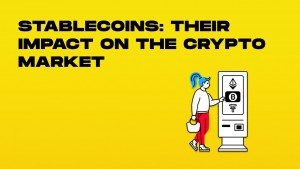Today, a retail trader can use a wide range of useful instruments and engage with all sorts of tradables enjoying the same smoothness and fidelity as in any other traditional financial framework. For example, you can easily employ an automatic trading bot to set up a massive HFT liquidity making system or quickly purchase various financial instruments at low prices without any lag or slippage.
In 2017, the selection of digital assets pegged by fiat expanded thanks to the introduction of MakerDAO with its $DAI and Circle’s USDC. It is important to remember that these digital currencies are different from other tokens since they are collateralized by other similar valuables and “real-world money”. For example, USDC and USDT, as the name suggests, are backed by the American dollar while DAI has a massive reserve fund.
The adoption rate of stablecoins in cryptocurrency has been notable during the last decade. By the end of 2023, the total market cap of this particular sector reached an impressive $130 billion mark with Tether holding the largest share (over $80 billion). This scale of adoption is due to the importance of predictable middlemen between the real world and the decentralized economy where they represent over 60% of total value locked across all platforms allowing for convenient borrowing, lending, and even yield farming. Projects like Aave or Compounds would not exist without them.
One of the recent trends in the industry is the use of these new decentralized systems for cross-border payments and remittances. Chainalysis conducted a large study of the global financial system from the perspective of sending remittances revealing that decentralized currencies backed by USD and euro are widely used as alternatives to traditional payment systems. This trend is especially visible in regions where banking is limited or local currencies do not inspire confidence in the participants of the economy.
What Are Stablecoins? A Beginner’s Guide to Price-Stable Digital Assets
It is a special category of cryptocurrencies specifically designed to adhere to a certain price and reduce volatility which is important for the health of economic activity as Bitcoin, Ethereum, and others are quite unpredictable. The idea behind the pioneer of the sector was to peg USDT to the most beloved reserve currency in the world. It worked out well. Soon, many other designs started appearing in the DeFi environment with coins collateralized by commodities, other valuables, and reserve currencies.
So, what is stablecoin? It is a fusion of various benefits that are traditionally associated with something like a golden standard in the economy. These are secure, can be used privately, and their transaction costs are very low. At the same time, they are reliable exchange mediums with the trustworthiness of underlying commodities and securities acting as a stabilization agent.
The Role of Stablecoins in the Crypto Industry and Financial Markets
They are primarily used as exchange mediums and reserve on DeFi platforms that focus on conducting transactions, lending, borrowing, or automatic market making. Since many of the services that were conceived during the last decade are focused on offering a variety of traditional financial products, it is necessary for the whole digital landscape to have these assets that do not suffer from volatility issues.
Depending on the type of valuables used as collateral in the architecture of a smart contract, they have different uses. Stablecoins and market stability are tightly connected things in the world of blockchain. Here are types of these coins based on the stabilization mechanism:
1. Backed by USD or Euro. While we are all well aware of commonly known coins where the underlying collateral is the US dollar, any other type of money can be used to issue similar coins on national and international levels.
2. Collateralized by other currencies. It is possible to create a reserve fund that will stabilize a newly issued currency using a variety of virtual valuables like in case with DAI where the bulk of reserve is comprised of ETH holdings.
3. Algorithmic coins. Controlling supply dynamically can be a good way to maintain a certain rate of appreciation or depreciation for longer periods which exactly what Ampleforth and similar projects are trying to achieve.
4. Collateralized by commodities. Gold, silver, and other precious metals can be used as collateral and create a good source of stability for anything tradable on centralized platforms. For example, Digix has each $DGX equal to the value of 1 gram of gold.
Different methods of stabilization allow these assets to provide immense utility and allow for quick transition of capital when necessary without trying to fill the gap between different networks and TradFi.
The Impact of Stablecoins on the Crypto Market: Benefits and Risks
The effect from these financial instruments is something that cannot be measured easily, but it is huge. We can say with certainty that without these useful mediums, we would have a series of independent projects with much lower operational volumes and adoption rates across the board. The very existence of exchange mediums allows for more flexibility and diversity in investment activities.
Here are some ways in which the variety of stabler exchange mediums affect the blockchain industry as a whole:
- Liquidity and reliability. Without liquidity, there is no cash flow and no interest from retail investors. The easily verifiable and stable value of commonly accepted mediums like BUSD or DAI allows for calculated decision-making and much better hedging approaches to be employed by all people who exchange resources. Locking in value in your favorite national money without actually leaving the digital ecosystem at all is a useful mechanism for enthusiasts who want to earn money quickly.
- DeFi support. DAI is an excellent example of a tool that allows for a variety of different functionality as it is used to lend, borrow, and provide liquidity on multiple platforms including Compound and Aave. Tokens that are supported by the US dollar and other valuables are acting as the driving force for the whole DeFi economy.
- Cross-border remittances. The traditional payment and money transferring system is quite slow and expensive compared to using blockchain solutions. This advantage is especially noticeable in regions where the majority of the population is unbanked or the national economy experiences tumultuous times leading to unstable exchange rates.
- On- and off-ramping. The main goal of several such projects is to bridge the gap between TradFi and DeFi by dramatically simplifying the process of purchasing and selling everything for newcomers and veterans alike. At the same time, USDT, BUSD, and USDC are used by centralized exchanges to ensure sufficient liquidity. Note that over three quarters of all BTC trading is done using the three aforementioned coins.
- Transparent operations. Many projects in the industry make sure to conduct audits regularly and increasing the level of transparency in the ecosystem. Third-party companies verify the validity of reports issued by Circle and prove that the circulation is backed by sufficient reserves. When every single person sees that everything is in order, their confidence of the mainstream audience in the future of “virtual money” grows.
- Encouraging innovation. The new age of financial products aimed at the cohort of contemporary capital holders and tech enthusiasts are often created on the foundation laid by the pioneers, MakerDAO, and Circle. For example, Sablier allows users to pay salaries in different types of digital valuables to ensure that employees have immediate access to their earnings.
- Regulation is easier. The absence of guardrails in the whole industry despite its novelty made it hard for newcomers to engage in economic activity and feel protected. The regulatory frameworks and their effects on the confidence of regular laymen are quite important. Recently, the EU started using the new set of regulatory rules called the MICA where the role and methods of use for such assets are outlined quite well.
How Stablecoins Affect the Broader Crypto Ecosystem
With the introduction of them to the blockchain industry, generating cash flow became much easier and more convenient for millions of active enthusiasts and money makers. The analysis of the sector can be done by approaching the process from the point of the traditional system by looking at currency prices and economic metrics. You can also look at the analytical process from a completely different angle by conducting the research using the corpora of data coming from CEXs and DEXs.
Many individual traders can use advanced tools like an AI crypto bot without any issues and easily read performance metrics having a clear picture of earnings denominated in US dollars. This convenience is a big reason why so many veterans of TradFi and newcomers without any experience decided to give investing in this area a try.
The positive effect of them on decentralized finance is undeniable and the success of projects like USD Coin and Binance USD provide a boost of confidence to all users around the globe. The adoption of these coins also lead to the increased democratization of the global financial system providing equal access to banking to people from regions where the financial infrastructure is lacking. This process opens new markets for DeFi services that are positioned to replace traditional payment systems in these regions.
























